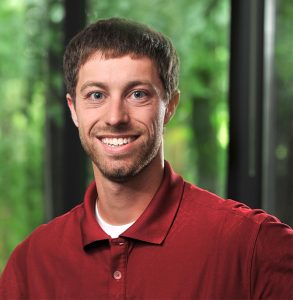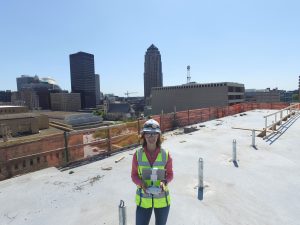Technology is changing the way engineers tackle challenges in the field. Iowa State civil, construction engineering alums weigh in.
Editor’s Note: This past winter, the department of civil, construction and environmental engineering at Iowa State University (ISU) released a survey to construction engineering alumni concerning possible changes to a program publication. In that survey, alums suggested that the department pursue a story related to the latest technological trends in engineering industries. Departmental communications reached out to members of CCEE GOLD, Graduates Of the Last Decade, to find engineering alumni close to the technological action of industry partners. The following is the result of alumni suggestions.
 |
 |
| Matt Goodhue and Jenny Herrera | |
The alums
The word “technology” has become synonymous with efficiency and success. New technological advancements drive markets and lead to major changes in the economic sectors of global economy. So how are civil, construction and environmental engineering graduates using technology in their day-to-day jobs? One word: drones.
Matt Goodhue and Jenny Herrera are project engineers for the Iowa business unit of The Weitz Company. Goodhue graduated from ISU in 2013 with a major in construction engineering. Herrera studied civil engineering and graduated in 2016. Together, they have logged nearly five years of drone operations experience.
Intro to UAVs
How did these alumni, who had no experience with drones prior to graduation, pick up these skills? In 2013, Goodhue started his career with Weitz. He was working on a senior living community project in Minnesota. One day, he was watching a YouTube video of a drone operator. Goodhue found the video so interesting that he forwarded it to his site superintendent. At the time, Weitz was paying a fee to an aerial photographer for progress photos of the site. Goodhue saw an opportunity to use a drone (or unmanned aerial vehicle, UAV) to take aerial photography and video.
“What it allowed us to do is see the whole project at once,” Goodhue said. No small feat, as the senior living complex stretched across a 46-acre site. By the time the project was done, the UAV had created an impact.
“It was helping us with our schedule and logistics in our planning meetings both internally and with the subcontractors,” he said. “We could communicate better and manage our schedule better.”
Herrera also started working for Weitz right after college. When the company announced that it was searching for employees interested in becoming UAV pilots, she leapt at the opportunity.
“We’re always trying to find the next big thing,” she said. “How can we be safer? How can we be more efficient? How can we continue to be the best in class? … As we move forward with technology, you can move faster.”
Safety, efficiency, accuracy

UAVs have become the newest technology on jobsites. What are some of the differences between drone images and traditional photographs of a construction location? Herrera and Goodhue emphasized how drone footage captures tough views easily. Herrera compared older construction photographic techniques to the 360-degree panoramic photo on a cell phone, in that images sometimes could look skewed. With a drone, difficult angles or towering heights present less of a challenge.
The engineers also say UAVs have a huge positive impact on safety. Take this example: Herrera is currently working on the Hilton Des Moines Downtown, a convention center hotel to be attached to the Iowa Events Center. When Weitz employees started positioning post-tension cables in concrete decks, Herrera used UAV technology to document the exact positions of the cables. Now that curtain wall is going up on the sides of the building, safely documenting the process is key.
“It’s not going to be a safety risk for me to fly the drone up to the eighth story and get a picture, as opposed to trying to get a person up there,” she explained.
Goodhue, who moved to Des Moines in 2016, adds that every UAV operator at the company must meet specific standards. The list includes safety protocols and preflight checks aimed to keep the operator, fellow engineers, and the UAV itself safe.
Technological stumbling blocks
The changes brought to construction sites by UAVs can be exciting. But Herrera and Goodhue admit that new technology can also throw a mean learning curve at both experienced and novice engineers.
“It’s changing so much that it’s harder for lots of people to keep up with it all,” Goodhue said. “If you don’t love technology and love experimenting with it, I think it could be a little frustrating to have all this new technology.”
Another frustration can be finding the best technology in a world flooded with new gadgets and software.
“I think, in the long run, there’s going to be a way to make a lot of things easier. That doesn’t necessarily mean the first thing that comes out is going to be the best option,” Herrera said.
Since technology is around for the long haul, both alums encourage fellow engineers to stick with it, even when the learning gets tough.
“I feel in the end, [technology] makes things a lot easier,” Goodhue said.

Advice to students
How can aspiring engineers get ready for the ever-changing world of occupational technology? The first suggestion is straightforward. “Take the time to learn those programs.”
“Don’t just do the project just to get it done,” Goodhue stressed. “Actually take the time to learn it, because all of the same programs that I used in college I’m using now.”
Goodhue urges students to brag up distinct skills, like rendering building models in 3-D or marking up PDFs. While finding a focus is important, Herrera encourages young engineers to explore opportunities.
“Be open to learning new things,” she said. “Once you have a base skill set, it’s going to be easier to learn how to use different programs.”
She also pushes students to find mentors who can answer difficult questions. A strong team makes a world of difference.
“People in engineering and construction work on teams for a reason,” she said. “It’s totally fine if you don’t know everything about one software. There is going to be someone else who does.”
Want to join CCEE GOLD? Email Jean Dubberke, CCEE Outreach Coordinator, at jeand@iastate.edu. Connect with fellow alums by following ISU CCEE on Facebook, Twitter, and LinkedIn (Iowa State University Civil, Construction and Environmental Engineering and ISUConE). If you have an interesting story idea, email CCEE Communications Specialist Kate Tindall at ktindall@iastate.edu.
